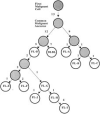Clonal evolution of B cells in transformation from low- to high-grade lymphoma
- PMID: 10229093
- PMCID: PMC4625534
- DOI: 10.1002/(SICI)1521-4141(199904)29:04<1253::AID-IMMU1253>3.0.CO;2-8
Clonal evolution of B cells in transformation from low- to high-grade lymphoma
Abstract
An outcome of low-grade B cell non-Hodgkins's lymphomas is the transformation to high-grade diffuse large B cell lymphomas (DLBL). To investigate the mechanisms of clonal evolution in the transformation to DLBL, we performed longitudinal molecular analyses of immunoglobulin (Ig), V(H)DJ(H) gene sequences expressed in cases of chronic lymphocytic leukemia (CLL), small lymphocytic lymphoma (SLL), and follicular lymphoma (FL) that transformed to DLBL. Among the neoplastic CLL and SLL cells and their respective high-grade transformants, there was no evidence for a clonotypic shift or acquired mutations in the expressed Ig V(H)DJ(H) gene segments, as further confirmed by a specific and sensitive PCR-single strand polymorphism analysis. In contrast, among the FL cells there was a high degree of intraclonal diversification with highly divergent V(H)DJ(H) gene sequences. Despite this intraclonal heterogeneity, the related DLBL expressed a collinear but unique V(H)DJ(H) gene sequence. The intraclonal genealogical tree for the FL case demonstrated that the DLBL emerged in association with unique V(H)DJ(H) gene mutational events. Among the intraclonal FL and related DLBL transformants, the nature and distribution of the Ig V(H)DJ(H) gene mutations were consistent with antigenic selection. Thus, clonal evolution in the transformation from low- to high-grade B cell lymphoma may involve distinct pathways which vary according to the cellular origin and the type of the progenitor B cell tumor.
Figures





Similar articles
-
Ongoing hypermutation in the Ig V(D)J gene segments and c-myc proto-oncogene of an AIDS lymphoma segregates with neoplastic B cells at different sites: implications for clonal evolution.Hum Immunol. 2000 Dec;61(12):1242-53. doi: 10.1016/s0198-8859(00)00181-6. Hum Immunol. 2000. PMID: 11163079
-
Lack of intraclonal diversification in Ig heavy and light chain V region genes expressed by CD5+IgM+ chronic lymphocytic leukemia B cells: a multiple time point analysis.J Immunol. 1998 Jan 15;160(2):820-30. J Immunol. 1998. PMID: 9551917 Free PMC article.
-
Histologic transformation of follicular lymphoma to diffuse lymphoma represents tumor progression by a single malignant B cell.J Exp Med. 1991 Jan 1;173(1):197-207. doi: 10.1084/jem.173.1.197. J Exp Med. 1991. PMID: 1898660 Free PMC article.
-
Immunoglobulin V gene expression in CD5 B-cell malignancies.Ann N Y Acad Sci. 1992 May 4;651:373-83. doi: 10.1111/j.1749-6632.1992.tb24638.x. Ann N Y Acad Sci. 1992. PMID: 1376056 Review.
-
Molecular analysis of immunoglobulin genes in multiple myeloma.Leuk Lymphoma. 1999 Apr;33(3-4):253-65. doi: 10.3109/10428199909058425. Leuk Lymphoma. 1999. PMID: 10221505 Review.
Cited by
-
Immunohistochemistry in bone marrow pathology: a useful adjunct for morphologic diagnosis.Virchows Arch. 2005 Dec;447(6):920-37. doi: 10.1007/s00428-005-0070-8. Epub 2005 Oct 18. Virchows Arch. 2005. PMID: 16231177 Review.
-
Chronic lymphocytic leukemia B cells can undergo somatic hypermutation and intraclonal immunoglobulin V(H)DJ(H) gene diversification.J Exp Med. 2002 Sep 2;196(5):629-39. doi: 10.1084/jem.20011693. J Exp Med. 2002. PMID: 12208878 Free PMC article.
-
Composite diffuse large B-cell lymphoma and follicular B-cell lymphoma - case report and review of literature.Maedica (Bucur). 2014 Jun;9(2):204-9. Maedica (Bucur). 2014. PMID: 25705280 Free PMC article.
-
Primary malignant lymphoma of the brain: mutation pattern of rearranged immunoglobulin heavy chain gene.Jpn J Cancer Res. 2002 Dec;93(12):1308-16. doi: 10.1111/j.1349-7006.2002.tb01239.x. Jpn J Cancer Res. 2002. PMID: 12495470 Free PMC article.
-
Primary cutaneous diffuse large B cell lymphoma relapsed solely as a huge lung tumor mimicking a primary pulmonary lymphoma.Int J Hematol. 2010 Jan;91(1):112-6. doi: 10.1007/s12185-009-0455-6. Epub 2009 Dec 12. Int J Hematol. 2010. PMID: 20012513
References
-
- Ersboll J, Schultz HB, Pedersen-Bjergaard J, Nissen NI. Follicular low-grade non-Hodgkins's lymphoma: long-term outcome with or without tumor progression. Eur. J. Haematol. 1989;42:155–163. - PubMed
-
- Harris NL, Jaffe ES, Stein H, Banks PM, Chan JK, Cleary ML, Delsol G, De Wolf-Peeters C, Falini B, Gatter KC. A revised European-American classification of lymphoid neoplasms: a proposal from the International Lymphoma Study Group. Blood. 1994;84:1361–1392. - PubMed
-
- Cullen MH, Lister TA, Brearley RI, Shand WS, Stansfeld AG. Histological transformation of non-Hodgkin's lymphoma: a prospective study. Cancer. 1979;44:645–651. - PubMed
-
- Garvin AJ, Simon RM, Osborne CK, Merrill J, Young RC, Berard CW. An autopsy study of histologic progression in non-Hodgkins's lymphomas. 192 cases from the National Cancer Institute. Cancer. 1983;52:393–398. - PubMed
-
- Harris NL, Ferry JA. Follicular lymphoma and related disorders (germinal center lymphomas). In: Knowles DM, editor. Neoplastic Hematopathology. Williams & Wilkins; Baltimore: 1992. pp. 645–674.
Publication types
MeSH terms
Substances
Grants and funding
LinkOut - more resources
Full Text Sources
Other Literature Sources

